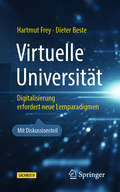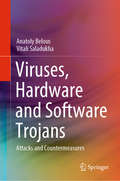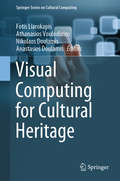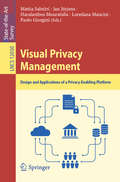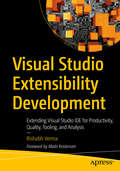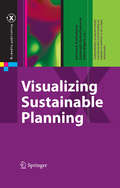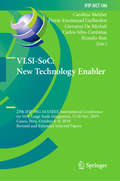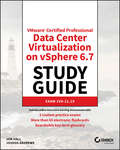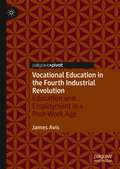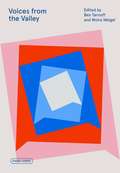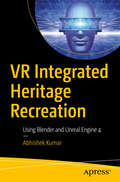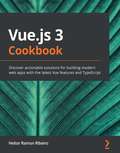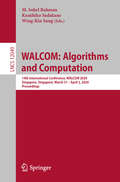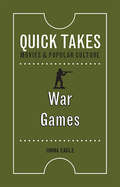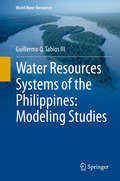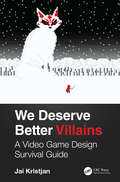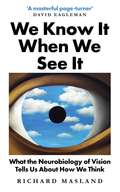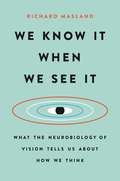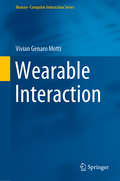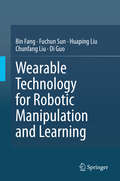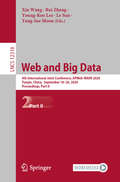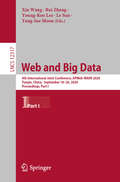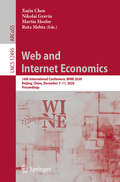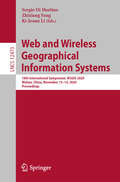- Table View
- List View
Virtuelle Universität: Digitalisierung erfordert neue Lernparadigmen (Technik im Fokus)
by Dieter Beste Hartmut FreyDas Buch vermittelt das Konzept einer globalen, virtuellen Universität in Kombination mit neuen Erkenntnissen aus der Lernforschung. Hierbei werden mithilfe von künstlicher Intelligenz bewegungsorientierte, virtuelle 3-D-Bilder eingebunden. Dadurch wird die Lernbereitschaft und damit auch die Kreativität des Einzelnen angeregt. So werden bereits heute Schweißer in Großunternehmen mittels Datenbrille und intelligenter Avatare ausgebildet. Über eine virtuelle Universität lassen sich Forschungsprojekte initiieren und koordinieren. Problemlösungen lassen sich mit der Verwendung von Avataren in virtuellen Hörsälen erarbeiten. Die Zertifizierung erfolgt nicht mehr über das Abfragen von Wissensinhalten, sondern über die Fähigkeit Probleme zu lösen. Weitere wichtige Aspekte einer virtuellen Universität sind, im Vergleich zu den klassischen Universitäten, die geringen Kosten, die Möglichkeit bei der Entwicklung des Contents die besten Wissenschaftler zu beteiligen sowie die immer mehr um sich greifende Sekundär- und Tertiärforschung. Eine virtuelle Universität bietet die Chance der Emanzipation gesellschaftlicher Praxis von Wissenschaft durch Wissenschaft und Immunisierung gesellschaftlich geltende Ideologien und Interessenstandpunkte gegen wissenschaftliche Aufklärungsansprüche.
Viruses, Hardware and Software Trojans: Attacks and Countermeasures
by Anatoly Belous Vitali SaladukhaThis book provides readers with a valuable reference on cyber weapons and, in particular, viruses, software and hardware Trojans. The authors discuss in detail the most dangerous computer viruses, software Trojans and spyware, models of computer Trojans affecting computers, methods of implementation and mechanisms of their interaction with an attacker — a hacker, an intruder or an intelligence agent. Coverage includes Trojans in electronic equipment such as telecommunication systems, computers, mobile communication systems, cars and even consumer electronics. The evolutionary path of development of hardware Trojans from "cabinets", "crates" and "boxes" to the microcircuits (IC) is also discussed. Readers will benefit from the detailed review of the major known types of hardware Trojans in chips, principles of their design, mechanisms of their functioning, methods of their introduction, means of camouflaging and detecting, as well as methods of protection and counteraction.
Visual Computing for Cultural Heritage (Springer Series on Cultural Computing)
by Anastasios Doulamis Fotis Liarokapis Athanasios Voulodimos Nikolaos DoulamisThis book provides insights into the state of the art of digital cultural heritage using computer graphics, image processing, computer vision, visualization and reconstruction, virtual and augmented reality and serious games. It aims at covering the emergent approaches for digitization and preservation of Cultural Heritage, both in its tangible and intangible facets. Advancements in Digital Cultural Heritage research have been abundant in recent years covering a wide assortment of topics, ranging from visual data acquisition, pre-processing, classification, analysis and synthesis, 3D modelling and reconstruction, semantics and symbolic representation, metadata description, repository and archiving, to new forms of interactive and personalized presentation, visualization and immersive experience provision via advanced computer graphics, interactive virtual and augmented environments, serious games and digital storytelling. Different aspects pertaining to visual computing with regard to tangible (books, images, paintings, manuscripts, uniforms, maps, artefacts, archaeological sites, monuments) and intangible (e.g. dance and performing arts, folklore, theatrical performances) cultural heritage preservation, documentation, protection and promotion are covered, including rendering and procedural modelling of cultural heritage assets, keyword spotting in old documents, drone mapping and airborne photogrammetry, underwater recording and reconstruction, gamification, visitor engagement, animated storytelling, analysis of choreographic patterns, and many more. The book brings together and targets researchers from the domains of computing, engineering, archaeology and the arts, and aims at underscoring the potential for cross-fertilization and collaboration among these communities.
Visual Privacy Management: Design and Applications of a Privacy-Enabling Platform (Lecture Notes in Computer Science #12030)
by Haralambos Mouratidis Paolo Giorgini Mattia Salnitri Jan Jürgens Loredana ManciniPrivacy is a burden for most organizations, the more complex and wider an organization is, the harder to manage and enforce privacy is.GDPR and other regulations on privacy impose strict constraints that must be coherently enforced, considering also privacy needs of organization and their users. Furthermore, organizations should allow their users to express their privacy needs easily, even when the process that manages users' data is complex and involves multiple organizations.Many research work consider the problem using simplistic examples, with solutions proposed that never actually touch pragmatic problems of real, large organizations, with thousands of users and terabytes of personal and sensitive data.This book faces the privacy management problem targeting actual large organizations, such as public administrations, including stakeholders in the process of definition of the solution and evaluating the results with its actual integration in four large organizations. The contribution of this book is twofold: a privacy platform that can be customized and used to manage privacy in large organizations; and the process for the design of such a platform, from a state-of-the-art survey on privacy regulations, through the definition of its requirements, its design and its architecture, until the evaluation of the platform.
Visual Studio Extensibility Development: Extending Visual Studio IDE for Productivity, Quality, Tooling, and Analysis
by Rishabh VermaLearn the extensibility model of Visual Studio to enhance the Visual Studio integrated development environment (IDE). This book will cover every aspect, starting from developing an extension to publishing it and making it available to the end user. The book begins with an introduction to the basic concepts of Visual Studio including data structures and design patterns and moves forward with the fundamentals of the VS extensibility model. Here you will learn how to work on Roslyn - the .NET compiler platform - and load extensions in VS. Next, you will go through the extensibility model and see how various extensions, such as menus, commands, and tool windows, can be plugged into VS. Moving forward, you’ll cover developing VS extensions and configuring them, along with demonstrations on customizing extension by developing option pages. Further, you will learn to create custom code snippets and use a debugger visualizer. Next, you will go through creation of project and item templates including deployment of VS extensions using continuous integration (CI). Finally, you will learn tips and tricks for Visual Studio and its extensibility and integration with Azure DevOps. After reading Visual Studio Extensibility Development you will be able to develop, deploy, and customize extensions in Visual Studio IDE. What You Will Learn Discover the Visual Studio extensibility and automation model Code Visual Studio extensions from scratchCustomize extensions by developing a tools option page for themCreate project templates, item templates, and code snippets. Work with code generation using T4 templatesCode analysis and refactoring using Roslyn analyzersCreate and deploy a private extension gallery and upload the extensions Upload a VS extension using CIShip your extension to Visual Studio MarketplaceWho This Book Is ForDevelopers in Visual Studio IDE covering C#, Visual Basic (VB), JavaScript, and CSS.
Visualizing Sustainable Planning
by Hans Hagen Subhrajit Guhathakurta Gerhard SteinebachThe authors present the state of the art in the rapidly growing field of visualization as related to problems in urban and regional planning. The significance and timeliness of this volume consist in its reflection of several developments in literature and the challenges cities are facing. First, the unsustainability of many of our current paradigms of development has become evidently clear. We are entering an era in which communities across the globe are strengthening their connections to the global flows of capital, goods, ideas, technologies and values while facing at the same time serious dislocations in their traditional socioeconomic structures. While the impending scenarios of climate change impacts remind us about the integrated ecological system that we are part of, the current discussions about global recession in the media alert us and make us aware of the occasional perils of the globalized economic system. The globally dispersed, intricately integrated and hyper-complex socioeconomic-ecological system is difficult to analyze, comprehend and communicate without effective visualization tools. Given that planners are at the frontlines in the effort to prepare as well as build resilience in the impacted communities, appropriate visualization tools are indispensable for effective planning. Second, planners have largely been slow to incorporate the advances in visualization research emerging from other domains of inquiry.
VLSI-SoC: 27th IFIP WG 10.5/IEEE International Conference on Very Large Scale Integration, VLSI-SoC 2019, Cusco, Peru, October 6–9, 2019, Revised and Extended Selected Papers (IFIP Advances in Information and Communication Technology #586)
by Carolina Metzler Pierre-Emmanuel Gaillardon Giovanni De Micheli Carlos Silva-Cardenas Ricardo ReisThis book contains extended and revised versions of the best papers presented at the 27th IFIP WG 10.5/IEEE International Conference on Very Large Scale Integration, VLSI-SoC 2019, held in Cusco, Peru, in October 2019. The 15 full papers included in this volume were carefully reviewed and selected from the 28 papers (out of 82 submissions) presented at the conference. The papers discuss the latest academic and industrial results and developments as well as future trends in the field of System-on-Chip (SoC) design, considering the challenges of nano-scale, state-of-the-art and emerging manufacturing technologies. In particular they address cutting-edge research fields like heterogeneous, neuromorphic and brain-inspired, biologically-inspired, approximate computing systems.
VMware Certified Professional Data Center Virtualization on vSphere 6.7 Study Guide: Exam 2V0-21.19
by Jon Hall Joshua AndrewsMaster vSphere 6 virtualization with hands-on practice and bonus preview exams VCP6-DCV: VMware Certified Professional-Data Center Virtualization on vSphere 6 Study Guide is your ultimate guide to preparing for exam 2VO-621. This Study Guide provides 100% coverage of all exam objectives and offers a unique set of study tools including assessment tests, objective map, real-world scenarios, hands-on exercises, and much more so you can be confident come exam day. You will also receive access to the superior Sybex interactive online learning environment that provides additional study tools including electronic flashcards and bonus practice exams. More than just a study guide, this book bridges the gap between exam prep and real-world on the job skills by focusing on the key information VMware professionals need to do the job. You'll master the vCenter Server and ESXi from planning and installation through upgrade and security, and develop an in-depth understanding of vSphere networking and storage, vApp deployment, service level establishment, troubleshooting, monitoring implementation, and so much more. Study 100% of exam 2V0-621 objectives Practice your skills with hands-on exercises Gain professional insight from real-world scenarios Test your understanding with review questions, practice tests, and more Virtualization is the number-one IT priority for organizations across public and private sectors, and VMware is the dominant force in the virtualization space. The VCP6-DCV certification gives you a highly marketable credential in terms of employment, but first you must pass this challenging exam. VCP6-DCV gives you the power of Sybex exam prep and the skills you need to excel at the job.
Vocational Education in the Fourth Industrial Revolution: Education and Employment in a Post-Work Age
by James AvisThis book examines the concept of the fourth industrial revolution and its potential impact on vocational education and training. Broadly located in a framework rooted in critical/radical theory, the book argues that the affordance of technologies surrounding the fourth industrial revolution are constrained by their location within a neoliberal, if not capitalist, logic. Thus, the impact of this revolution will be experienced differently across European regions as well as low and middle income economies. In order to break this impasse, this book calls for a politics based on non-reformist reforms, premised on an aspiration towards a socially just society that transcends capitalism.
Voices from the Valley: Tech Workers Talk About What They Do--and How They Do It (FSG Originals x Logic)
by Ben Tarnoff Moira WeigelFrom FSGO x Logic: anonymous interviews with tech workers at all levels, providing a bird's-eye view of the industryIn Voices from the Valley, the celebrated writers and Logic cofounders Moira Weigel and Ben Tarnoff take an unprecedented dive into the tech industry, conducting unfiltered, in-depth, anonymous interviews with tech workers at all levels, including a data scientist, a start-up founder, a cook who serves their lunch, and a PR wizard. In the process, Weigel and Tarnoff open the conversation about the tech industry at large, a conversation that has previously been dominated by the voices of CEOs. Deeply illuminating, revealing, and at times lurid, Voices from the Valley is a vital and comprehensive view of an industry that governs our lives.FSG Originals × Logic dissects the way technology functions in everyday lives. The titans of Silicon Valley, for all their utopian imaginings, never really had our best interests at heart: recent threats to democracy, truth, privacy, and safety, as a result of tech’s reckless pursuit of progress, have shown as much. We present an alternate story, one that delights in capturing technology in all its contradictions and innovation, across borders and socioeconomic divisions, from history through the future, beyond platitudes and PR hype, and past doom and gloom. Our collaboration features four brief but provocative forays into the tech industry’s many worlds, and aspires to incite fresh conversations about technology focused on nuanced and accessible explorations of the emerging tools that reorganize and redefine life today.
VR Integrated Heritage Recreation: Using Blender and Unreal Engine 4
by Abhishek KumarCreate assets for history-based games. This book covers the fundamental principles required to understand and create architectural visualizations of historical locations using digital tools. You will explore aspects of 3D design visualization and VR integration using industry-preferred software. Some of the most popular video games in recent years have historical settings (Age of Empires, Call of Duty, etc.). Creating these games requires creating historically accurate game assets. You will use Blender to create VR-ready assets by modeling and unwrapping them. And you will use Substance Painter to texture the assets that you create.You will also learn how to use the Quixel Megascans library to acquire and implement physically accurate materials in the scenes. Finally, you will import the assets into Unreal Engine 4 and recreate a VR integrated heritage that can be explored in real time. Using VR technology and game engines, you can digitally recreate historical settings for games.What You Will LearnCreate high-quality, optimized models suitable for any 3D game engineMaster the techniques of texturing assets using Substance Painter and Quixel MegascansKeep assets historically accurateIntegrate assets with the game engineCreate visualizations with Unreal Engine 4Who Is This Book ForGame developers with some experience who are eager to get into VR-based games
Vue.js 3 Cookbook: Discover actionable solutions for building modern web apps with the latest Vue features and TypeScript
by Heitor Ramon RibeiroExplore the new features of Vue.js 3 and discover best practices for building fault-tolerant and professional frontend web applications Key Features Migrate your apps from Vue.js 2 to Vue.js 3 with the help of practical recipes Explore the latest Vue.js 3 features such as reactivity API, composition API, and TypeScript support Extend the capabilities and performance of Vue.js apps with Quasar, Vuetify, and Nuxt.js frameworks Book Description Vue.js is a progressive web framework for building professional user interfaces for your web applications. With Vue.js 3, the frontend framework is reinforced with architectural enhancements, new base languages, new render processes, and separated core components. The book starts with recipes for implementing Vue.js 3's new features in your web development projects and migrating your existing Vue.js apps to the latest version. You will get up and running with TypeScript with Vue.js and find succinct solutions to common challenges and pitfalls faced in implementing components, derivatives, and animation, through to building plugins, adding state management, routing, and developing complete single-page applications (SPAs). As you advance, you'll discover recipes to help you integrate Vue.js apps with Nuxt.js in order to add server-side rendering capabilities to your SPAs. You'll then learn about the Vue.js ecosystem by exploring modern frameworks such as Quasar, Nuxt.js, Vuex, and Vuetify in your web projects. Finally, the book provides you with solutions for packaging and deploying your Vue.js apps. By the end of this Vue.js book, you'll be able to identify and solve challenges faced in building Vue.js applications and be able to adopt the Vue.js framework for frontend web projects of any scale. What you will learn Design and develop large-scale web applications using Vue.js 3's latest features Create impressive UI layouts and pages using Vuetify, Buefy, and Ant Design Extend your Vue.js applications with dynamic form and custom rules validation Add state management, routing, and navigation to your web apps Extend Vue.js apps to the server-side with Nuxt.js Discover effective techniques to deploy your web applications with Netlify Develop web applications, mobile applications, and desktop applications with a single code base using the Quasar framework Who this book is for The book is for both new and experienced Vue.js developers looking to overcome challenges in building dynamic web applications with Vue 3. Knowledge of JavaScript and a basic understanding of Vue.js will help you to make the most of this book.
WALCOM: 14th International Conference, WALCOM 2020, Singapore, Singapore, March 31 – April 2, 2020, Proceedings (Lecture Notes in Computer Science #12049)
by Kunihiko Sadakane M. Sohel Rahman Wing-Kin SungThis book constitutes the refereed proceedings of the 14th International Conference on Algorithms and Computation, WALCOM 2020, held in Singapore in March/April 2020. The 23 full and 4 short papers presented were carefully reviewed and selected from 66 submissions. The papers focus on algorithmic graph theory and combinatorics, computational biology, computational geometry, data structures, experimental algorithm methodologies, graph algorithms, graph drawing, parallel and distributed algorithms, network optimization.
The War Against the BBC: How an Unprecedented Combination of Hostile Forces Is Destroying Britain's Greatest Cultural Institution... And Why You Should Care
by Patrick Barwise Peter YorkThere's a war on against the BBC. It is under threat as never before. And if we lose it, we won't get it back.The BBC is our most important cultural institution, our best-value entertainment provider, and the global face of Britain. It's our most trusted news source in a world of divisive disinformation. But it is facing relentless attacks by powerful commercial and political enemies, including deep funding cuts - much deeper than most people realise - with imminent further cuts threatened. This book busts the myths about the BBC and shows us how we can save it, before it's too late.
War Games (Quick Takes: Movies and Popular Culture)
by Jonna EagleThe word “wargames” might seem like a contradiction in terms. After all, the declaration “This is war” is meant to signal that things have turned deadly serious, that there is no more playing around. Yet the practices of war are intimately entangled with practices of gaming, from military videogames to live battle reenactments. How do these forms of play impact how both soldiers and civilians perceive acts of war? This Quick Take considers how various war games and simulations shape the ways we imagine war. Paradoxically, these games grant us a sense of mastery and control as we strategize and scrutinize the enemy, yet also allow us the thrilling sense of being immersed in the carnage and chaos of battle. But as simulations of war become more integrated into both popular culture and military practice, how do they shape our apprehension of the traumatic realities of warfare? Covering everything from chess to football, from Saving Private Ryan to American Sniper, and from Call of Duty to drone interfaces, War Games is an essential guide for anyone seeking to understand the militarization of American culture, offering a compact yet comprehensive look at how we play with images of war.
Water Resources Systems of the Philippines: Modeling Studies (World Water Resources #4)
by Guillermo Q. Tabios IIIThis book presents a number of modeling studies of various water resources systems in the humid tropics and the typical short, steep mountain-to-coast systems in the archipelagic setting of the Philippines. Covering natural and rural systems, urban watersheds and built systems, such as reservoirs and flood control systems, it discusses modeling studies based on pure simulation and combined optimization-simulation. The book offers insights into real-world water resources modeling, and as such is a valuable resource for academics and practitioners in the Philippines, as well as those in other Asian regions with similar water resources systems, and similar issues, problems and concerns.
We Deserve Better Villains: A Video Game Design Survival Guide
by Jai KristjanWe Deserve Better Villains is a highly accessible how-to guide for video game designers no matter what level of experience to understand what is needed to be successful in the development cycle of any video game from concept to supporting the game live. Each chapter outlines a period in a video games development cycle, what key concepts need to be on a designers mind and how they can work to improve themselves every step of the way. To help visualize the journey the chapters start with a section centered on the reader as a hero character in a fictitious adventure video game that faces the trials and tribulations of the development cycle to completing the game. We all deserve better games, better heroes and villains which starts with learning what it takes to survive in the game development system as a videogame designer. Key Features Accessible enough for novices, insightful enough for veteran game designers Allows readers of at any level of video game knowledge to connect with the struggle of making a video game Concepts are delivered in a short, specific approach followed with practical exercises to follow to getting the reader into action to improve their skills
We Know It When We See It: What the Neurobiology of Vision Tells Us About How We Think
by Richard MaslandSpotting a face in a crowd is so easy, you take it for granted. But how you do it is one of science's great mysteries. Vision is involved in nearly a third of everything a brain does and explaining how it works reveals more than just how we see. It also tells us how the brain processes information – how it perceives, learns and remembers. In We Know It When We See It, pioneering neuroscientist Richard Masland covers everything from what happens when light hits your retina, to the increasingly sophisticated nerve nets that turn that light into knowledge, to what a computer algorithm must be able to do before it can truly be called &‘intelligent&’. It is a profound yet accessible investigation into how our bodies make sense of the world.
We Know It When We See It: What the Neurobiology of Vision Tells Us About How We Think
by Richard Maslandp.p1 {margin: 0.0px 0.0px 0.0px 0.0px; font: 13.3px Times} A Harvard researcher investigates the human eye in this insightful account of what vision reveals about intelligence, learning, and the greatest mysteries of neuroscience.Spotting a face in a crowd is so easy, you take it for granted. But how you do it is one of science's great mysteries. And vision is involved with so much of everything your brain does. Explaining how it works reveals more than just how you see. In We Know It When We See It, Harvard neuroscientist Richard Masland tackles vital questions about how the brain processes information -- how it perceives, learns, and remembers -- through a careful study of the inner life of the eye. Covering everything from what happens when light hits your retina, to the increasingly sophisticated nerve nets that turn that light into knowledge, to what a computer algorithm must be able to do before it can be called truly "intelligent," We Know It When We See It is a profound yet approachable investigation into how our bodies make sense of the world.
Wearable Interaction (Human–Computer Interaction Series)
by Vivian Genaro MottiThis book offers the reader a comprehensive view of the design space of wearable computers, cutting across multiple application domains and interaction modalities. Besides providing several examples of wearable technologies, Wearable Interaction illustrates how to create and to assess interactive wearables considering human factors in design decisions related to input entry and output responses. The book also discusses the impacts of form factors and contexts of use in the design of wearable interaction. Miniaturized components, flexible materials, and sewable electronics toolkits exemplify advances in technology that facilitated the design and development of wearable technologies. Despite such advances, creating wearable interfaces that are efficient is still challenging. The new affordances of on-body interfaces require the consideration of new interaction paradigms, so that the design decisions for the user interaction take into account key limitations in the interaction surfaces of wearables concerning input entry, processing power for output responses, and in the time and attention that wearers dedicate to complete their interaction. Under such constraints, creating interfaces with high usability levels is complex. Also, because wearables are worn continuously and in close contact with the human body, on-body interfaces must be carefully designed to neither disturb nor overwhelm wearers. The context of use and the potential of wearable technologies must be both well understood to provide users with relevant information and services using appropriate approaches and without overloading them with notifications. Wearable Interaction explains thoroughly how interactive wearables have been created taking into account the needs of end users as well as the vast potential that wearable technologies offer. Readers from academia, industry or government will learn how wearables can be designed and developed to facilitate human activities and tasks across different sectors.
Wearable Technology for Robotic Manipulation and Learning
by Bin Fang Fuchun Sun Huaping Liu Chunfang Liu Di GuoOver the next few decades, millions of people, with varying backgrounds and levels of technical expertise, will have to effectively interact with robotic technologies on a daily basis. This means it will have to be possible to modify robot behavior without explicitly writing code, but instead via a small number of wearable devices or visual demonstrations. At the same time, robots will need to infer and predict humans’ intentions and internal objectives on the basis of past interactions in order to provide assistance before it is explicitly requested; this is the basis of imitation learning for robotics. This book introduces readers to robotic imitation learning based on human demonstration with wearable devices. It presents an advanced calibration method for wearable sensors and fusion approaches under the Kalman filter framework, as well as a novel wearable device for capturing gestures and other motions. Furthermore it describes the wearable-device-based and vision-based imitation learning method for robotic manipulation, making it a valuable reference guide for graduate students with a basic knowledge of machine learning, and for researchers interested in wearable computing and robotic learning.
Web and Big Data: 4th International Joint Conference, APWeb-WAIM 2020, Tianjin, China, September 18-20, 2020, Proceedings, Part II (Lecture Notes in Computer Science #12318)
by Xin Wang Rui Zhang Young-Koo Lee Le Sun Yang-Sae MoonThis two-volume set, LNCS 11317 and 12318, constitutes the thoroughly refereed proceedings of the 4th International Joint Conference, APWeb-WAIM 2020, held in Tianjin, China, in September 2020. Due to the COVID-19 pandemic the conference was organizedas a fully online conference. The 42 full papers presented together with 17 short papers, and 6 demonstration papers were carefully reviewed and selected from 180 submissions. The papers are organized around the following topics: Big Data Analytics; Graph Data and Social Networks; Knowledge Graph; Recommender Systems; Information Extraction and Retrieval; Machine Learning; Blockchain; Data Mining; Text Analysis and Mining; Spatial, Temporal and Multimedia Databases; Database Systems; and Demo.
Web and Big Data: 4th International Joint Conference, APWeb-WAIM 2020, Tianjin, China, September 18-20, 2020, Proceedings, Part I (Lecture Notes in Computer Science #12317)
by Xin Wang Rui Zhang Young-Koo Lee Le Sun Yang-Sae MoonThis two-volume set, LNCS 11317 and 12318, constitutes the thoroughly refereed proceedings of the 4th International Joint Conference, APWeb-WAIM 2020, held in Tianjin, China, in September 2020. Due to the COVID-19 pandemic the conference was organizedas a fully online conference. The 42 full papers presented together with 17 short papers, and 6 demonstration papers were carefully reviewed and selected from 180 submissions. The papers are organized around the following topics: Big Data Analytics; Graph Data and Social Networks; Knowledge Graph; Recommender Systems; Information Extraction and Retrieval; Machine Learning; Blockchain; Data Mining; Text Analysis and Mining; Spatial, Temporal and Multimedia Databases; Database Systems; and Demo.
Web and Internet Economics: 16th International Conference, WINE 2020, Beijing, China, December 7–11, 2020, Proceedings (Lecture Notes in Computer Science #12495)
by Xujin Chen Nikolai Gravin Martin Hoefer Ruta MehtaThis book constitutes the proceedings of the 16th International Conference on Web and Internet Economics, WINE 2020, held in Beijing, China, in December 2020. The 31 full papers presented together with 11 abstracts were carefully reviewed and selected from 136 submissions. The issues in theoretical computer science, artificial intelligence, operations research are of particular importance in the Web and the Internet that enable the interaction of large and diverse populations. The Conference on Web and Internet Economics (WINE) is an interdisciplinary forum for the exchange of ideas and results on incentives and computation arising from these various fields.
Web and Wireless Geographical Information Systems: 18th International Symposium, W2GIS 2020, Wuhan, China, November 13–14, 2020, Proceedings (Lecture Notes in Computer Science #12473)
by Sergio Di Martino Zhixiang Fang Ki-Joune LiThis book constitutes the refereed proceedings of the 18th International Symposium on Web and Wireless Geographical Information Systems, W2GIS 2019, held in Wuhan, China, in November 2020. The 8 full papers presented together with 15 progress papers or short papers in the volume were carefully reviewed and selected from 40 submissions. The papers cover topics that range from mobile GIS and Location-Based Services to Spatial Information Retrieval and Wireless Sensor Networks
